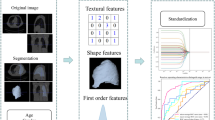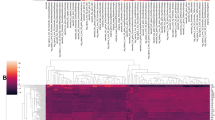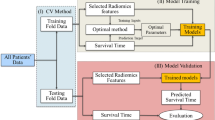Abstract
Tumor phenotypes can be characterized by radiomics features extracted from images. However, the prediction accuracy is challenged by difficulties such as small sample size and data imbalance. The purpose of the study was to evaluate the performance of machine learning strategies for the prediction of cancer prognosis. A total of 422 patients diagnosed with non-small cell lung carcinoma (NSCLC) were selected from The Cancer Imaging Archive (TCIA). The gross tumor volume (GTV) of each case was delineated from the respective CT images for radiomic features extraction. The samples were divided into 4 groups with survival endpoints of 1 year, 3 years, 5 years, and 7 years. The radiomic image features were analyzed with 6 different machine learning methods: decision tree (DT), boosted tree (BT), random forests (RF), support vector machine (SVM), generalized linear model (GLM), and deep learning artificial neural networks (DL-ANNs) with 70:30 cross-validation. The overall average prediction performance of the BT, RF, DT, SVM, GLM and DL-ANNs was AUC with 0.912, 0.938, 0.793, 0.746, 0.789 and 0.705 respectively. The RF and BT gave the best and second performance in the prediction. The DL-ANN did not show obvious advantage in predicting prognostic outcomes. Deep learning artificial neural networks did not show a significant improvement than traditional machine learning methods such as random forest and boosted trees. On the whole, the accurate outcome prediction using radiomics serves as a supportive reference for formulating treatment strategy for cancer patients.

Similar content being viewed by others
Data Availability
The data is available upon request to: Professor F.H. Tang by email: fhtang@twc.edu.hk
References
Lambin P, Rios-Velazquez E, Leijenaar R, Carvalho S, Van Stiphout RG, Granton P, et al. Radiomics: extracting more information from medical images using advanced feature analysis. European journal of cancer. 2012;48(4):441-6.
Zierhut D, Bettscheider C, Schubert K, Van Kampen M, Wannenmacher M. Radiation therapy of stage I and II non-small cell lung cancer (NSCLC). Lung Cancer. 2001;34:39-43.
Kumar V, Gu Y, Basu S, Berglund A, Eschrich SA, Schabath MB, et al. Radiomics: the process and the challenges. Magnetic resonance imaging. 2012;30(9):1234-48.
GGillies R, Kinahan P, Hricak H. Radiomics: Images Are More than Pictures. They Are Data Radiology. 2016;278(2):563-77.
FH T, CYW C, EYW C. Radiomics AI prediction for head and neck squamous cell carcinoma (HNSCC) prognosis and recurrence with target volume approach. BJR| Open. 2021;3:20200073.
Liu Z, Zhang XY, Shi YJ, Wang L, Zhu HT, Tang Z, et al. Radiomics analysis for evaluation of pathological complete response to neoadjuvant chemoradiotherapy in locally advanced rectal cancer. Clinical Cancer Research. 2017;23(23):7253-62.
Bogowicz M, Riesterer O, Ikenberg K, Stieb S, Moch H, Studer G, et al. Computed tomography radiomics predicts HPV status and local tumor control after definitive radiochemotherapy in head and neck squamous cell carcinoma. International Journal of Radiation Oncology* Biology* Physics. 2017;99(4):921-8.
Singh A. Foundations of Machine Learning. International Journal of Radiation Oncology* Biology* Physics. 2019.
Kotsiantis SB, Zaharakis ID, Pintelas PE. Machine learning: a review of classification and combining techniques. Artificial Intelligence Review. 2006;26(3):159-90.
Osisanwo F, Akinsola J, Awodele O, Hinmikaiye J, Olakanmi O, Akinjobi J. Supervised machine learning algorithms: classification and comparison. International Journal of Computer Trends and Technology (IJCTT). 2017;48(3):128-38.
Parmar C, Grossmann P, Bussink J, Lambin P, Aerts HJ. Machine learning methods for quantitative radiomic biomarkers. Scientific reports. 2015;5(1):1-11.
Li Z, Wang Y, Yu J, Guo Y, Cao W. Deep learning based radiomics (DLR) and its usage in noninvasive IDH1 prediction for low grade glioma. Scientific reports. 2017;7(1):1-11.
Avanzo M, Wei L, Stancanello J, Vallieres M, Rao A, Morin O, et al. Machine and deep learning methods for radiomics. Medical physics. 2020;47(5):e185-202.
Xue C, Zhu L, Fu H, Hu X, Li X, Zhang H, et al. Global guidance network for breast lesion segmentation in ultrasound images. Medical image analysis. 2021;70:101989.
Xue C, Dou Q, Shi X, Chen H, Heng PA. Robust learning at noisy labeled medical images: Applied to skin lesion classification. In: 2019 IEEE 16th International Symposium on Biomedical Imaging (ISBI 2019). IEEE; 2019. p. 1280-3.
Xue C, Deng Q, Li X, Dou Q, Heng PA. Cascaded robust learning at imperfect labels for chest x-ray segmentation. In: International Conference on Medical Image Computing and Computer-Assisted Intervention. Springer; 2020. p. 579-88.
Clark K, Vendt B, Smith K, Freymann J, Kirby J, Koppel P, et al. The Cancer Imaging Archive (TCIA): maintaining and operating a public information repository. Journal of digital imaging. 2013;26(6):1045-57.
Van Griethuysen JJ, Fedorov A, Parmar C, Hosny A, Aucoin N, Narayan V, et al. Computational radiomics system to decode the radiographic phenotype. Cancer research. 2017;77(21):e104-7.
Cortes C, Mohri M. Confidence intervals for the area under the ROC curve. Advances in neural information processing systems. 2004;17.
R Core Team. R: A Language and Environment for Statistical Computing. Vienna, Austria; 2021. Available from: https://www.R-project.org/.
Park S, Lee SM, Kim S, Choi S, Kim W, Do KH, et al. Performance of radiomics models for survival prediction in non-small-cell lung cancer: influence of CT slice thickness. European Radiology. 2021;31(5):2856-65.
Lao J, Chen Y, Li ZC, Li Q, Zhang J, Liu J, et al. A deep learning-based radiomics model for prediction of survival in glioblastoma multiforme. Scientific reports. 2017;7(1):1-8.
Liu X, Zhang D, Liu Z, Li Z, Xie P, Sun K, et al. Deep learning radiomics-based prediction of distant metastasis in patients with locally advanced rectal cancer after neoadjuvant chemoradiotherapy: A multicentre study. EBioMedicine. 2021;69:103442.
Vils A, Bogowicz M, Tanadini-Lang S, Vuong D, Saltybaeva N, Kraft J, et al. Radiomic Analysis to Predict Outcome in Recurrent Glioblastoma Based on Multi-Center MR Imaging From the Prospective DIRECTOR Trial. Frontiers in oncology. 2021;11:1097.
Zhang Y, Oikonomou A, Wong A, Haider MA, Khalvati F. Radiomics-based prognosis analysis for non-small cell lung cancer. Scientific reports. 2017;7(1):1-8.
Oshiro TM, Perez PS, Baranauskas JA. How many trees in a random forest? In: International workshop on machine learning and data mining in pattern recognition. Springer; 2012. p. 154-68.
Boulesteix AL, Janitza S, Kruppa J, König IR. Overview of random forest methodology and practical guidance with emphasis on computational biology and bioinformatics. Wiley Interdisciplinary Reviews: Data Mining and Knowledge Discovery. 2012;2(6):493-507.
Wei Q, Dunbrack Jr RL. The role of balanced training and testing data sets for binary classifiers in bioinformatics. PloS one. 2013;8(7):e67863.
Xu Y, Hosny A, Zeleznik R, Parmar C, Coroller T, Franco I, et al. Deep learning predicts lung cancer treatment response from serial medical imaging. Clinical Cancer Research. 2019;25(11):3266-75.
Song YY, Ying L. Decision tree methods: applications for classification and prediction. Shanghai archives of psychiatry. 2015;27(2):130.
Chen T, Guestrin C. Xgboost: A scalable tree boosting system. In: Proceedings of the 22nd acm sigkdd international conference on knowledge discovery and data mining; 2016. p. 785-94.
Bandos TV, Bruzzone L, Camps-Valls G. Classification of hyperspectral images with regularized linear discriminant analysis. IEEE Transactions on Geoscience and Remote Sensing. 2009;47(3):862-73.
ANN vs CNN vs RNN: Types of Neural Networks;. Accessed: 2021-05-15. https://www.analyticsvidhya.com/blog/2020/02/cnn-vs-rnn-vs-mlp-analyzing-3-types-of-neural-networks-in-deep-learning/.
Funding
We acknowledged the University Grants Council Faculty Development Scheme grant UGC/FDS17/M10/19 for support of model development of this project and Tung Wah College for the support of article publication charge. On behalf of all authors, the corresponding author states that there is no conflict of interest.
Author information
Authors and Affiliations
Contributions
Conceptualization, F.-H.T.; methodology, C.X., C.Y.W., T.H.C., C.K.L; data acquisition, C.K.L.; writing—original draft preparation, C.Y.W. and T.H.C; writing—review and editing, F.-H.T., C.X. and M.Y.L; All authors have read and agreed to the published version of the manuscript.
Corresponding author
Ethics declarations
Ethics Approval
This study used public dataset; no ethics approval is required.
Additional information
Publisher’s Note
Springer Nature remains neutral with regard to jurisdictional claims in published maps and institutional affiliations.
Appendix
Appendix
Summary of machine learning methods and ROC curves for all the methods.
Rights and permissions
Springer Nature or its licensor (e.g. a society or other partner) holds exclusive rights to this article under a publishing agreement with the author(s) or other rightsholder(s); author self-archiving of the accepted manuscript version of this article is solely governed by the terms of such publishing agreement and applicable law.
About this article
Cite this article
Tang, Fh., Xue, C., Law, M.Y. et al. Prognostic Prediction of Cancer Based on Radiomics Features of Diagnostic Imaging: The Performance of Machine Learning Strategies. J Digit Imaging 36, 1081–1090 (2023). https://doi.org/10.1007/s10278-022-00770-0
Received:
Revised:
Accepted:
Published:
Issue Date:
DOI: https://doi.org/10.1007/s10278-022-00770-0









